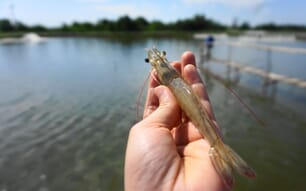Robust smolts are characterized by Castro as smolts that have improved disease resistance associated with a strengthened cardiovascular system and better growth.
Start while they are young
Castro and his colleagues at Nofima measured the extent to which these parameters were improved by different physical training regimes in salmon juveniles (pre-smolts) in fresh water, thereby improving smolt robustness.
Overall, his work demonstrates that by subjecting pre-smolts to physical exercise, there is a strong potential for the aquaculture industry to produce more robust smolts.
This can in turn result in lower mortalities caused by infectious diseases. Production losses are particularly high the first months after sea transfer, so preventive health measures must be initiated in juvenile fish during the freshwater stage.
How to train a fish
As salmon swim constantly, aerobic exercise training is achieved by changing the water velocity and flow conditions in the tanks so that the fish are motivated to swim in a controlled way and at higher speeds than normal over time.
In the trials at Nofima (the Norwegian Institute of Food, Fisheries and Aquaculture Research), several different training regimes with intervals and continuous flow were tested.
Greatest benefit for poor swimmers
In one trial, Castro split the salmon population into two groups: good and poor swimmers. Interestingly, the fish that were categorized as good swimmers had an overall higher disease resistance than poor swimmers on a controlled infectious pancreatic necrosis (IPN) challenge test. After undergoing the physical training programs, the largest effect on disease resistance was recorded in the group of poor swimmers, with two outcomes.
Their performance was either improved through an optimal regime (achieving similar resistance level as good swimmers), or worsened through a non-optimal regime. This suggests that poor swimmers have lower capability to adapt than good swimmers.
The range of swimming velocity that appears to be optimal for improving overall robustness has been narrowed down by Castro and the research group. While it was earlier thought that 0.5-1.5 body lengths per second was optimal, they now have data that shows that 08 1.2 body lengths per second is optimal when including improved disease resistance.
In conclusion, aerobic exercise is good for all salmon but the weakest 50 percent of the fish may have the greatest benefit from swimming activity, says Castro.
Physical exercise improved the growth rate, mainly because of an increased feed intake, meaning that fish will reach a given size faster when undergoing training programs than if they are not subjected to such programs.
Why training is good
To understand why training strengthens the disease resistance of the fish, Castro performed functional genomics studies, which uses genetic information to describe the functions and interactions of genes.
These studies showed that favorable physical training reduced inflammation levels in the heart and the innate immune system was strengthened through activation of several responses. These responses were probably instrumental in the researchers being able to find a lower reproduction of the virus in fish that had undergone physical training. Furthermore, results suggested that physical exercise had a strong effect on enhancing the cardiovascular capacity of the fish, an important factor in achieving high levels of robustness.
In future research, we need to further optimize the physical training regimes, so we can implement protocols with the potential of large benefits for the fish, the industry and the consumers, Castro emphasizes.
Possible utilization of this knowledge may also include improving the genetic material in breeding programs by sorting fish based on swimming performance.
Vicente Castro is 31 years old and is from Chile. On 29 June 2012, he defended his thesis entitled Aerobic exercise training for improving robustness of Atlantic salmon (Salmo salar) at the Norwegian University of Life Sciences. His supervisors were Senior Researcher Dr. Harald Takle from Nofima and Professor Dr. Stle Helland from the Department of Animal and Aquacultural Sciences and Nofima.




